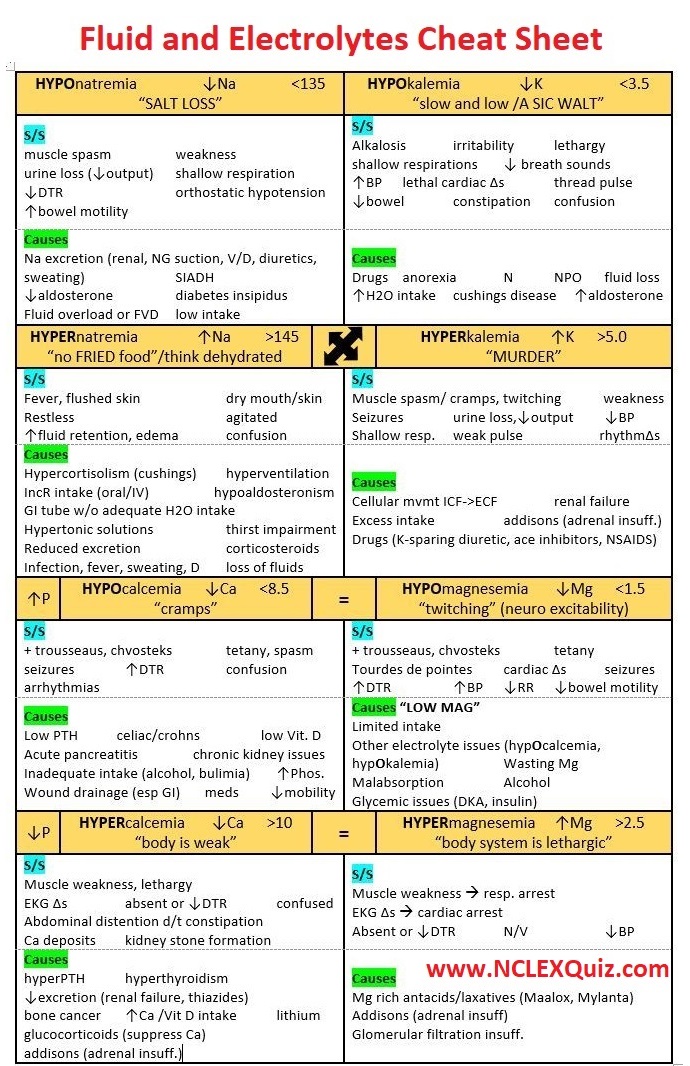
Fluid and Electrolyte Imbalance Chart Fluid/Electrolyte Imbalance Causes Signs/Symptoms Lab
Buy Metrics Abstract Maintaining the balance of fluid and electrolytes is crucial to the care of patients across the continuum. To do this, a practitioner must be cognizant of key monitoring and assessment parameters.

RiskForFluidAndElectrolyteImbalance Sample NCP PDF Electrolyte Intravenous Therapy
There are many nursing diagnoses applicable to fluid, electrolyte, and acid-base imbalances. Review a nursing care planning resource for current NANDA-I approved nursing diagnoses, related factors, and defining characteristics. See Table 15.6c for commonly used NANDA-I diagnoses associated with patients with fluid and electrolyte imbalances. [12]

Good to know Nursing school tips, Nursing school studying, Nursing school survival
Fluid volume deficit (also known as hypovolemia) is a state or condition where the fluid output exceeds the fluid intake. It occurs when the body loses both water and electrolytes from the ECF in similar proportions. FVD should not be confused with dehydration, however; dehydration refers to loss of water alone, with increased serum sodium levels.

Electrolyte Imbalance Nursing Care Plan
Identifying risks and possible causes helps formulate a care plan that will prevent confusion and changes in mentation. Interventions: 1. Assist in correcting fluid and electrolyte imbalance. Fluid and electrolyte imbalances can cause acute confusion. Addressing and correcting these imbalances will help resolve acute confusion. 2.

10 Fluid And Electrolyte Imbalances Nursing Care Plans Nurseslabs Nursing care plan, Nursing
Fluid Volume Excess is a nursing diagnosis that is defined as an increase in isotonic fluid retention. A guide for nursing care plan.. In addition to monitoring laboratory work for results indicating fluid imbalance, electrolytes, specifically sodium, potassium, calcium,. Includes detailed nursing care plan guides for common nursing.

Electrolyte Imbalance Nursing Diagnosis and Nursing Care Plan (2023)
Causes Several factors can contribute to electrolyte abnormalities. Some of the potential causes include: Vomiting Diarrhea Excessive or insufficient fluid volume Other medical conditions (i.e. renal failure, congestive heart failure, hypothyroidism) Medications (i.e. diuretics) Signs and Symptoms Hypernatremia Excessive thirst Agitation

Fluid and Electrolyte Imbalances Nursing cheat sheet Nursing Student www.tambonpasak.go.th
Ashley's nursing care plan goal for this patient includes maintaining fluid volumes and laboratory values at normal levels. Ashley knows the two major types of fluid imbalances are volume and.

10 Fluid And Electrolyte Imbalances Nursing Care Plans Nursing care plan, Electrolytes
Fluid and electrolyte balance is a dynamic process that is crucial for life and homeostasis. Fluid occupies almost 60% of the weight of an adult. Body fluid is located in two fluid compartments: the intracellular space and the extracellular space.

Nursing Diagnosis & Care Plan for Fluid and Electrolyte Imbalance Student’s Guide
Validation of 15 fluid and electrolyte nursing interventions is a significant contribution to the development of a classification of nursing interventions, as well as the development of nursing science. Through this validation process, experts have asserted that nurses do make independent decisions and practice autonomously in the area of caring for patients with fluid and electrolyte problems.

NCP Electrolyte imbalance
Electrolyte Imbalance can be defined as the disproportion of electrolytes in the body which can affect the regulation of many bodily processes such as blood acidity and blood pressure, hydration status, nerve and muscle functions, and rebuilding of damaged tissues.

Major Fluid and Electrolyte imbalance signs and symptoms by nurses note Nurses Note
Updated: Apr 28, 2023 Published Mar 29, 2023 Workforce Development Columnist Melissa Mills, BSN Specializes in Workforce Development, Education, Advancement. This article was reviewed and fact-checked by our Editorial Team. Table of Contents Signs & Symptoms Assessment Factors Affecting Causes Treatments Complications Nurse's Role

Electrolyte Imbalance Care Plan Rose Pdf
4. Teach healthy adults and patients how to prevent dehydration. 5. Assess patients for factors that increase the risk for fluid and electrolyte imbalances, especially for older adults. 6. Teach patients at risk for fluid or electrolyte imbalances as a result of drug therapy about the manifestations of the imbalance.

Surgical Nursing (NSRG 102) Electrolyte Chart imbalances
Table 15.6d. Interventions for Imbalances. Nursing Diagnosis. Interventions. Excessive Fluid Volume. Administer prescribed diuretics to eliminate excess fluid as appropriate and monitor for effect. Monitor for side effects of diuretics such as orthostatic hypotension and electrolyte imbalances. Position the patient with the head of the bed.

Nursing Care Plan for "Fluid and Electrolyte Imbalances"
The balancing act. Fluid and electrolyte balance play an important role in homeostasis, and critical care nurses assume a vital role in identifying and treating the physiologic stressors experienced by critically ill patients that disrupt homeostasis. 1. Electrolytes, found in body fluids, are electrically charged particles (ions).

ER Fluid Additive Cheat Sheet Interventions for copd patient in respiratory failure
Fluid and Electrolyte Imbalances: Interpretation and Assessment. 2016 Nov/Dec;39 (6):382-386. doi: 10.1097/NAN.0000000000000193. Maintaining the balance of fluid and electrolytes is crucial to the care of patients across the continuum. To do this, a practitioner must be cognizant of key monitoring and assessment parameters. Key electrolytes.

Electrolyte Imbalances Nursing Study Guide Etsy Nursing study guide, Electrolytes imbalance
Table 15.6c provides a list of common NANDA-I nursing diagnoses related to fluid and electrolyte imbalances, such as dehydration, excess fluid volume, and risk for electrolyte imbalance. The table also includes the etiology, defining characteristics, and related factors for each diagnosis. This is a useful resource for nurses who want to identify and address the problems of their patients with.